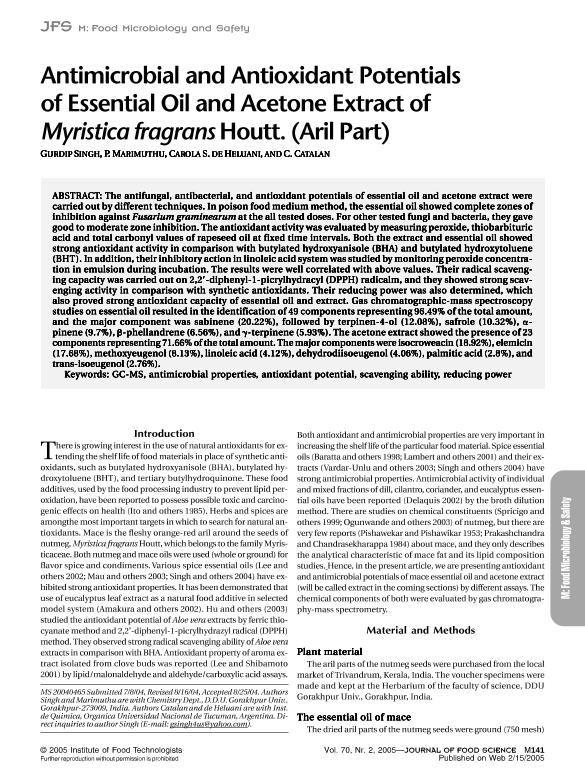Mostrar el registro sencillo del ítem
dc.contributor.author
Singh, Gurdip
dc.contributor.author
Marimuthu, P.
dc.contributor.author
De Heluani, Carola S.
dc.contributor.author
Catalan, Cesar Atilio Nazareno

dc.date.available
2020-03-13T19:42:20Z
dc.date.issued
2005-12
dc.identifier.citation
Singh, Gurdip; Marimuthu, P.; De Heluani, Carola S.; Catalan, Cesar Atilio Nazareno; Antimicrobial and antioxidant potentials of essential oil and acetone extract of Myristica fragrans Houtt. (aril part); Wiley Blackwell Publishing, Inc; Journal of Food Science; 70; 2; 12-2005
dc.identifier.issn
0022-1147
dc.identifier.uri
http://hdl.handle.net/11336/99558
dc.description.abstract
The antifungal, antibacterial, and antioxidant potentials of essential oil and acetone extract were carried out by different techniques. In poison food medium method, the essential oil showed complete zones of inhibition against Fusarium graminearum at the all tested doses. For other tested fungi and bacteria, they gave good to moderate zone inhibition. The antioxidant activity was evaluated by measuring peroxide, thiobarbituric acid and total carbonyl values of rapeseed oil at fixed time intervals. Both the extract and essential oil showed strong antioxidant activity in comparison with butylated hydroxyanisole (BHA) and butylated hydroxytoluene (BHT). In addition, their inhibitory action in linoleic acid system was studied by monitoring peroxide concentration in emulsion during incubation. The results were well correlated with above values. Their radical scavenging capacity was carried out on 2,2′-diphenyl-1-picrylhydracyl (DPPH) radicalm, and they showed strong scavenging activity in comparison with synthetic antioxidants. Their reducing power was also determined, which also proved strong antioxidant capacity of essential oil and extract. Gas chromatographic-mass spectroscopy studies on essential oil resulted in the identification of 49 components representing 96.49% of the total amount, and the major component was sabinene (20.22%), followed by terpinen-4-ol (12.08%), safrole (10.32%), α-pinene (9.7%), β-phellandrene (6.56%), and γ-terpinene (5.93%). The acetone extract showed the presence of 23 components representing 71.66% of the total amount. The major components were isocroweacin (18.92%), elemicin (17.68%), methoxyeugenol (8.13%), linoleic acid (4.12%), dehydrodiisoeugenol (4.06%), palmitic acid (2.8%), and trans-isoeugenol (2.76%). © 2005 Institute of Food Technologists.
dc.format
application/pdf
dc.language.iso
eng
dc.publisher
Wiley Blackwell Publishing, Inc

dc.rights
info:eu-repo/semantics/openAccess
dc.rights.uri
https://creativecommons.org/licenses/by-nc-sa/2.5/ar/
dc.subject
ANTIMICROBIAL PROPERTIES
dc.subject
ANTIOXIDANT POTENTIAL
dc.subject
GC-MS
dc.subject
REDUCING POWER
dc.subject
SCAVENGING ABILITY
dc.subject.classification
Química Orgánica

dc.subject.classification
Ciencias Químicas

dc.subject.classification
CIENCIAS NATURALES Y EXACTAS

dc.title
Antimicrobial and antioxidant potentials of essential oil and acetone extract of Myristica fragrans Houtt. (aril part)
dc.type
info:eu-repo/semantics/article
dc.type
info:ar-repo/semantics/artículo
dc.type
info:eu-repo/semantics/publishedVersion
dc.date.updated
2020-03-11T18:31:35Z
dc.journal.volume
70
dc.journal.number
2
dc.journal.pais
Reino Unido

dc.journal.ciudad
Londres
dc.description.fil
Fil: Singh, Gurdip. Deen Dayal Upadhyay Gorakhpur University India; India
dc.description.fil
Fil: Marimuthu, P.. Deen Dayal Upadhyay Gorakhpur University India; India
dc.description.fil
Fil: De Heluani, Carola S.. Universidad Nacional de Tucumán; Argentina
dc.description.fil
Fil: Catalan, Cesar Atilio Nazareno. Universidad Nacional de Tucumán; Argentina. Consejo Nacional de Investigaciones Científicas y Técnicas. Centro Científico Tecnológico Conicet - Tucumán. Instituto de Química del Noroeste. Universidad Nacional de Tucumán. Facultad de Bioquímica, Química y Farmacia. Instituto de Química del Noroeste; Argentina
dc.journal.title
Journal of Food Science

dc.relation.alternativeid
info:eu-repo/semantics/altIdentifier/url/https://www.onlinelibrary.wiley.com/doi/epdf/10.1111/j.1365-2621.2005.tb07105.x
dc.relation.alternativeid
info:eu-repo/semantics/altIdentifier/doi/https://doi.org/10.1111/j.1365-2621.2005.tb07105.x
Archivos asociados
